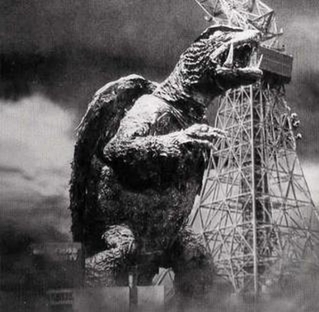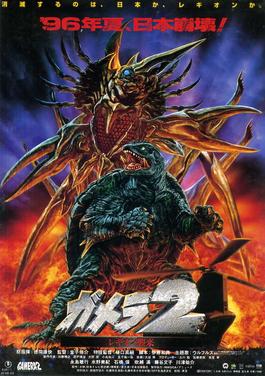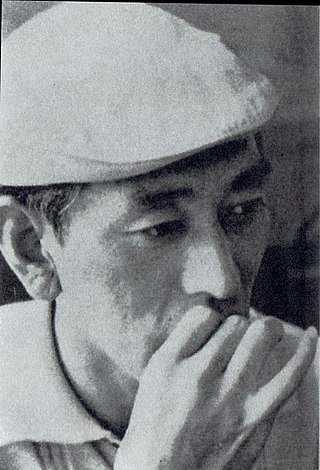
Gamera is a fictional monster, or kaiju, originating from a series of Japanese films. Debuting in the 1965 film Gamera, the Giant Monster, the character and the first film were intended to compete with the success of Toho's Godzilla film series. Since then, Gamera has become a Japanese icon in his own right, appearing in a total of 12 films produced by Daiei Film and later by Tokuma Shoten and Kadokawa Daiei Studio respectively, and various other media such as novelizations, manga, video games, and so on.
The Nikkatsu Corporation is a Japanese entertainment company known for its film and television productions. The name Nikkatsu amalgamates the words Nippon Katsudō Shashin, literally "Japan Motion Pictures".

Toei Company, Ltd. is a Japanese entertainment company. Headquartered in Ginza, Chūō, Tokyo, it is involved in film and television production, distribution, video game development, publishing, and ownership of 34 movie theaters. Toei also owns and operates studios in Tokyo and Kyoto and holds shares in several television companies. The company is renowned for its production of anime and live-action dramas known as tokusatsu, which incorporate special visual effects. It is also known for producing period dramas. Internationally, Toei is the majority shareholder of Toei Animation and is recognized for its franchises such as Kamen Rider and Super Sentai.

Shochiku Co., Ltd. is a Japanese entertainment company. It started its business in 1895 by managing kabuki theaters in Kyoto, and in 1914, it also acquired ownership of the Kabuki-za theater in Tokyo. In 1920, Shochiku entered the film production industry and established the Kamata Film Studio. Currently, it is considered one of Japan's Big Four film studios and is the oldest among the Big Four. Shochiku is a member of the Motion Picture Producers Association of Japan (MPPAJ).
Shintoho Co. Ltd. was a Japanese movie studio. It was one of the big six film studios during the Golden Age of Japanese cinema. It was founded by defectors from the original Toho company following a bitter strike in 1947.

Gamera: Super Monster is a 1980 Japanese kaiju film directed by Noriaki Yuasa and produced by Daiei Film. It is the eighth film in the Gamera film series, following the release of Gamera vs. Zigra in 1971.

Gamera 2: Attack of Legion is a 1996 Japanese kaiju film directed by Shusuke Kaneko, with special effects by Shinji Higuchi. Produced by Daiei Film and distributed by Toho, the film is the 10th entry in the Gamera film series, as well as the second film in the franchise's Heisei period, serving as a direct sequel to the 1995 film Gamera: Guardian of the Universe. The film stars Toshiyuki Nagashima, Miki Mizuno, Tamotsu Ishibashi, and Mitsuru Fukikoshi, with Ayako Fujitani and Yukijirō Hotaru reprising their roles from the previous film, and with Akira Ohashi portraying the giant turtle monster Gamera.

Virus, known in Japan as Fukkatsu no Hi, is a 1980 Japanese post-apocalyptic science fiction film directed by Kinji Fukasaku. Based on Sakyo Komatsu's 1964 novel of the same name, the film stars an international ensemble cast featuring Masao Kusakari, Sonny Chiba, George Kennedy, Robert Vaughn, Chuck Connors, Olivia Hussey, Edward James Olmos, Glenn Ford, and Henry Silva.
Masayuki Ochiai is a Japanese film director. His films include Kansen and Saimin.

Noriaki Yuasa was a Japanese director. Yuasa was the main director of the Japanese film series Gamera, about a giant flying turtle that befriends small boys and battles giant monsters; he directed seven of the first eight films in the series while also providing special effects for one of them. The series was created by Daiei Film Studios after the box office success of the Toho Godzilla series.

Nobuhiko Obayashi was a Japanese director, screenwriter and editor of films and television advertisements. He began his filmmaking career as a pioneer of Japanese experimental films before transitioning to directing more mainstream media, and his resulting filmography as a director spanned almost 60 years. He is best known as the director of the 1977 horror film House, which has garnered a cult following. He was notable for his distinct surreal filmmaking style, as well as the anti-war themes commonly embedded in his films.

Daiei Film Co. Ltd. was a Japanese film studio. Founded in 1942 as Dai Nippon Film Co., Ltd., it was one of the major studios during the postwar Golden Age of Japanese cinema, producing not only artistic masterpieces, such as Akira Kurosawa's Rashomon (1950) and Kenji Mizoguchi's Ugetsu (1953), but also launching several film series, such as Gamera, Zatoichi and Yokai Monsters, and making the three Daimajin films (1966). It declared bankruptcy in 1971 and was acquired by Kadokawa Pictures.

Kenji Misumi was a Japanese film director. He created film series such as Lone Wolf and Cub and the initial film in the long-running Zatoichi series, and also directed Hanzo the Razor: Sword of Justice, starring Shintaro Katsu. He died at age 54.

The Ghost Cat of Otama Pond is a 1960 Japanese horror film directed and co-written by Yoshihiro Ishikawa, in his directorial debut. Produced by Shintoho, it belongs to the subgenre of "ghost cat" films, featuring a cat-like supernatural entity.

Ghost Cat of Yonaki Swamp, also known as Necromancy, is a 1957 Japanese horror film directed by Katsuhiko Tasaka. It stars Shintaro Katsu and Takako Irie, the latter known for her roles in "ghost cat" films, with her appearance in Ghost Cat of Yonaki Swamp being her fifth and final such role.